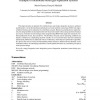Free Online Productivity Tools
i2Speak
i2Symbol
i2OCR
iTex2Img
iWeb2Print
iWeb2Shot
i2Type
iPdf2Split
iPdf2Merge
i2Bopomofo
i2Arabic
i2Style
i2Image
i2PDF
iLatex2Rtf
Sci2ools
CCE
2010
2010
Combined mass and energy integration in process design at the example of membrane-based gas separation systems
This paper presents an approach for combined mass and energy integration in process synthesis and illustrates it at the thermochemical production of crude synthetic natural gas (SNG) from lignocellulosic biomass and its separation in a membrane cascade. Based on a general process superstructure, the design problem is decomposed into non-linear unit models whose energy and mass balances are used as constraints in mixed integer linear programming (MILP) that targets the maximum combined production of fuel, heat and power. The flowsheet structure and its operating conditions are thereby considered as complicating decision variables in an overall non-linear and non-continuous optimisation problem that is addressed with an evolutionary, multi-objective optimisation algorithm. In a process that uses its waste and intermediate product streams to balance the heat demand, such a formulation allows for identifying intensified, overall optimal flowsheets by considering all aspects of the process...
CCE 2010 | General Process Superstructure | Non-continuous Optimisation Problem | Non-linear Unit Models | Software Engineering |
| Added | 28 Feb 2011 |
| Updated | 28 Feb 2011 |
| Type | Journal |
| Year | 2010 |
| Where | CCE |
| Authors | Martin Gassner, François Maréchal |
Comments (0)

